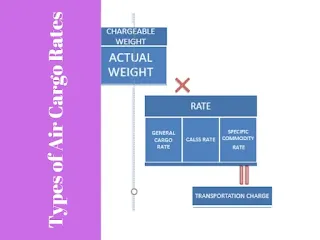Air cargo rates " weight charge" of any shipment may never be lower than the published minimum charge from the point of origin to the point of destination of the shipment. In my previous article, I learnt you how to calculate chargeable weight for any shipment. Today, I am going to explain you the different air cargo rates. This article will give you the basic knowledge which help you to understand the calculating of air cargo rates in my next articles.
I hope you enjoying reading air cargo instructor website, and feel free to contact us or leave your comment to let us know what your opinion regarding our contents.
Before starting explaining this subject, you should understand the meaning of the following two terms (rates, charges), which highly used in calculating air cargo shipping costs from point (a) to point (b).
What Do We Mean by Air Cargo Rates?
Simply, the air cargo rates is the amount charged by airline or shipping agent for the carriage of unite of weight ( kg. or lb.). As rule, we use the applicable air cargo rate which are published by airline - or shipping agent – either in IATA TACT Online or through another publishing method such as website or online air freight calculating services.
These air cargo rates must be in effect on the date of issuance of the air waybill by the airline or its cargo agent.
What Do We Mean by Air Cargo Charges ?
The air cargo charge is the amount to be paid for the transport of shipment or for incidental services in connection with such transportation. Simply, when we determine the correct chargeable weight for any shipment, we multiplying the applicable air cargo rate per kg. or lb. by the chargeable weight, the result of this calculation is called air cargo charges for transporting of the shipment.
Note: there is another term " other charges", these include charges for government tax, ground handling, security check etc.
I am sure, you got the point and you understand what is the meaning of the two terms (rates, charges). Now, I will explain you the different air cargo rates to be able to understand the difference between them, and be able to understand my next articles which will discuss and explain each one separately.
Types of Air Cargo Rates
There are different air cargo rates listed below:
1- Minimum Charge
Airlines pay operational costs for carriage each shipment. Also, when the shipment is light in weight or small, it needs to be handled like other big shipments. For these reasons, airlines publish air cargo minimum charge to cover its operational costs, and for additional care of small shipment from being lost or missed during transportation. In no event shall the carriage for any shipment be less that the minimum charges published by airline in IATA TACT Book or thought its website etc.
Note : specific commodity rate, class rate and general freight rate will be covered in separate articles in the future.
2- General Cargo Rate
If your shipment is not allocated as specific commodity rate as describe below, and not classified under one of many commodities under the air cargo class rate– as described below too- then we assume that air cargo general rate is applicable " general cargo rate GCR ".
Note : Dangerous goods shipments allocated as " general cargo rate GCR ".
3- Specific Commodity Rates (SCR)
Specific commodity rate is usually lower than general cargo rates and are published for particular commodity from a specific point of origin to specific destination point. For example, Fish (Edible), Seafood is considered as specific commodity [ no. 0300], when it is shipped from Yemen to France the specific commodity rate is applied. Applying this air freight rule give the shipper lower price for 500 kgs of fish if we compared by general cargo rate.
4- Class Rates (SCR)
This air cargo rate applies to a few commodities with or between certain designated IATA areas. Cargo class rates are usually stated in terms of a percentage either:
- Increase, or
- Reduction
In the normal general cargo rates. For example, human remain (coffin) will costs 200% of normal general cargo rate if being shipped by air within IATA area 2.
5- Unitized Shipments
For shippers that use unit load devices for transporting more than shipment, airline give him special rates less than general cargo rate.
Note : specific commodity rate, class rate, Unitized Shipments and general cargo rate will be covered in separate articles in the future.
Summary
To ship any shipment, you will be charged by the airline for the carriage of the total kgs or lbs. Airlines publish its rates per kg. or lb., for each two points (origin, destination). The rate per unit of weight called " rate" while the total amount paid for the carriage of total kgs or lbs. call "charges".
There are many types of air freight rates :
1- Minimum Charge
2- General Freight Rate " General Cargo Rate (GCR) "
3- Specific Commodity Rates (SCR)
4- Class Rates (SCR)
5- Unitized Shipments
Air cargo rates is included in one of the most important marketing mix " price ". Airlines determine the rates while writing their air cargo marketing plan.

